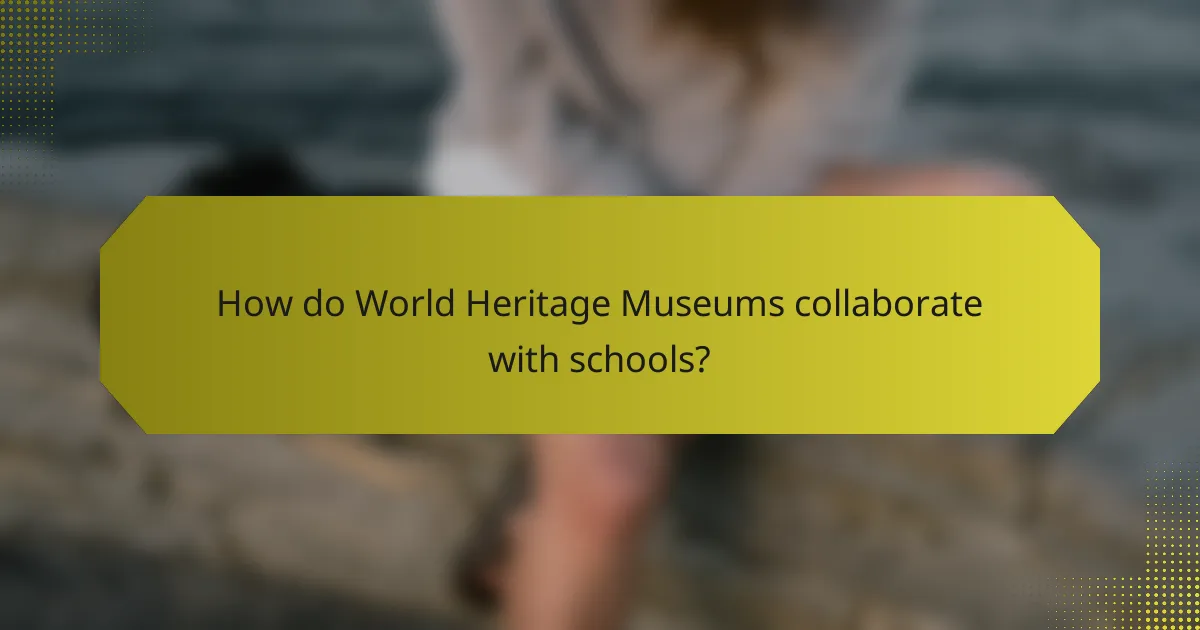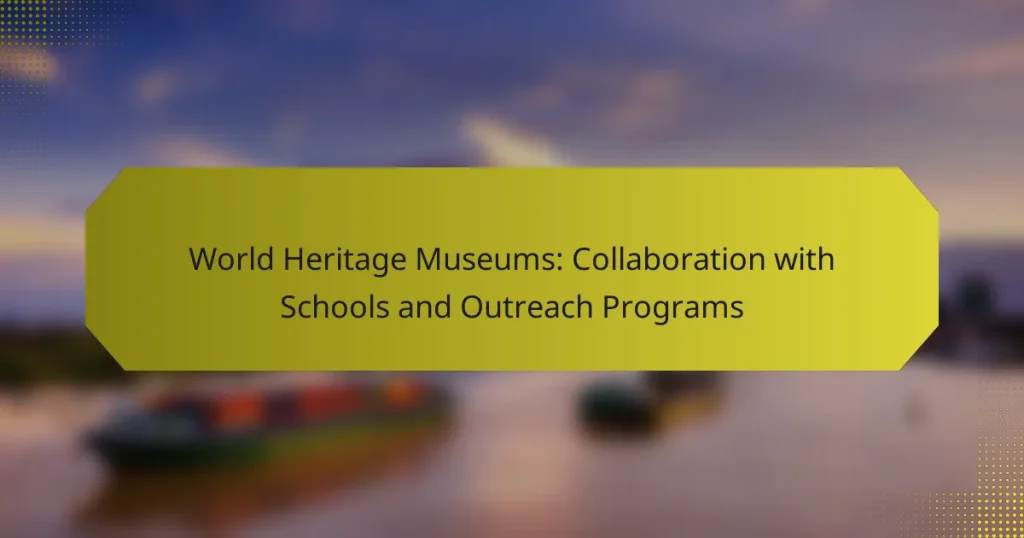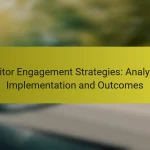World Heritage Museums play a vital role in education by collaborating with schools through a range of initiatives that promote cultural appreciation and enhance learning. These partnerships offer students unique opportunities to engage with museum resources via workshops, field trips, and collaborative projects, fostering a deeper understanding of heritage. Additionally, outreach programs connect local communities with the museum’s mission, providing interactive experiences that enrich educational opportunities for families and schools alike.

How do World Heritage Museums collaborate with schools?
World Heritage Museums collaborate with schools through various educational initiatives designed to enhance learning and cultural appreciation. These partnerships often include workshops, curriculum integration, field trips, guest lectures, and collaborative projects that engage students with the museum’s resources and expertise.
Educational workshops
Educational workshops are hands-on sessions where students can engage directly with museum artifacts and themes. These workshops often focus on specific topics, such as art conservation or historical storytelling, allowing students to learn through interactive experiences.
Typically, workshops can accommodate groups of varying sizes, often ranging from 15 to 30 students, and can be tailored to different age groups. Schools should consider scheduling these workshops in advance to secure their preferred dates.
Curriculum integration
World Heritage Museums often work with educators to integrate museum resources into existing school curricula. This collaboration can involve aligning museum exhibits with specific subjects, such as history or science, creating lesson plans that utilize museum materials.
Teachers can benefit from this integration by accessing specialized resources and expertise, which can enhance student engagement and understanding. Schools should communicate their curriculum needs to museum staff to develop effective partnerships.
Field trips and tours
Field trips to World Heritage Museums provide students with the opportunity to experience cultural heritage firsthand. These visits often include guided tours that highlight significant exhibits and provide context for the artifacts on display.
Schools should plan these trips to coincide with relevant lessons, ensuring that students can connect their classroom learning with real-world experiences. Consideration of transportation logistics and potential costs is essential for successful planning.
Guest lectures by museum staff
Guest lectures by museum staff offer students insights from experts in various fields, including archaeology, art history, and conservation. These lectures can be conducted in-person or virtually, making them accessible to a wider range of schools.
Schools should coordinate with museums to schedule these lectures, focusing on topics that align with the students’ interests and curriculum. Engaging with museum professionals can inspire students and deepen their understanding of cultural heritage.
Collaborative projects
Collaborative projects between museums and schools can take many forms, such as joint exhibitions or research initiatives. These projects encourage students to work alongside museum staff, fostering a sense of ownership and connection to cultural heritage.
Schools interested in collaborative projects should reach out to museums to discuss potential ideas and resources. Establishing clear goals and timelines is crucial for the success of these partnerships, ensuring that both parties benefit from the collaboration.

What outreach programs do World Heritage Museums offer?
World Heritage Museums provide a variety of outreach programs designed to engage local communities, enhance educational opportunities, and promote cultural awareness. These initiatives often include interactive workshops, online resources, and events that connect families and schools with the museum’s mission and collections.
Community engagement initiatives
Community engagement initiatives at World Heritage Museums focus on building relationships with local residents through collaborative projects. These programs may include art exhibitions featuring local artists, cultural festivals, and workshops that encourage participation from diverse groups.
For example, museums might host storytelling sessions or craft workshops that reflect the heritage of the surrounding community. Such initiatives not only foster a sense of belonging but also promote the museum as a cultural hub.
Online educational resources
World Heritage Museums offer a range of online educational resources to support teachers and students. These resources often include lesson plans, virtual tours, and interactive activities that align with educational standards.
Many museums provide free access to digital archives and multimedia content, allowing users to explore artifacts and exhibitions from home. This accessibility is particularly beneficial for schools with limited field trip budgets.
Family days and public events
Family days and public events are designed to attract visitors of all ages, offering hands-on activities and entertainment. These events often feature guided tours, live demonstrations, and performances that highlight the museum’s collections.
Special days may include themed activities, such as “Archaeology Day” or “Cultural Heritage Festival,” where families can engage in learning through play. These events help demystify the museum experience and encourage repeat visits.
Volunteer programs
Volunteer programs at World Heritage Museums provide opportunities for community members to get involved and contribute to the museum’s mission. Volunteers may assist with educational programs, event planning, or conservation efforts.
Participating in these programs can enhance personal skills and provide valuable experience in the cultural sector. Museums often seek volunteers from various backgrounds, making it a great way to connect with others who share an interest in heritage and education.

What are the benefits of museum-school partnerships?
Museum-school partnerships provide significant advantages by enhancing educational experiences and fostering community engagement. These collaborations create opportunities for students to connect with cultural resources, enriching their learning and understanding of heritage.
Enhanced student learning
Partnerships between museums and schools lead to improved student learning outcomes by integrating hands-on experiences with classroom instruction. Students can engage with artifacts and exhibitions, which deepens their understanding of subjects like history and science.
Teachers can develop tailored lesson plans that align with museum offerings, allowing students to explore topics in a more interactive and memorable way. This experiential learning often results in higher retention rates and increased enthusiasm for the subject matter.
Access to unique resources
Museums offer access to unique resources that schools may not have, including specialized collections, expert staff, and interactive exhibits. These resources can enhance curriculum delivery and provide students with insights that textbooks alone cannot offer.
For example, a local art museum might provide original artworks for study, while a science museum could offer live demonstrations or workshops. This access can significantly enrich the educational experience and inspire students’ creativity and curiosity.
Promotion of cultural heritage
Collaborating with museums helps promote cultural heritage by exposing students to diverse histories and traditions. This exposure fosters appreciation and respect for different cultures, which is essential in today’s global society.
Schools can organize field trips to museums or invite museum educators to conduct workshops, allowing students to learn about their own cultural backgrounds as well as those of others. Such initiatives can strengthen community ties and encourage students to become advocates for cultural preservation.
Development of critical thinking skills
Museum-school partnerships encourage the development of critical thinking skills through inquiry-based learning. Students are prompted to ask questions, analyze information, and engage in discussions about the exhibits they encounter.
By participating in activities like guided tours or interactive workshops, students learn to evaluate sources, form arguments, and draw conclusions based on evidence. These skills are vital not only in academic settings but also in everyday decision-making and civic engagement.

How do museums measure the impact of outreach programs?
Museums measure the impact of outreach programs through various methods that assess participant engagement, satisfaction, and overall effectiveness. These measurements help museums understand the value of their initiatives and guide future improvements.
Surveys and feedback from participants
Surveys are a primary tool for collecting feedback from participants in outreach programs. Museums often distribute questionnaires after events to gauge satisfaction levels, learning outcomes, and suggestions for improvement. This direct feedback can highlight strengths and areas needing enhancement.
In addition to surveys, informal feedback through discussions or focus groups can provide deeper insights into participant experiences. Engaging with attendees in this way fosters a sense of community and encourages ongoing dialogue.
Attendance and engagement metrics
Attendance figures are a straightforward way to measure outreach program impact. Tracking the number of participants over time can reveal trends and help museums assess the effectiveness of their marketing efforts. For instance, a significant increase in attendance may indicate successful outreach strategies.
Engagement metrics, such as the duration of visits or participation in activities, also provide valuable data. Museums can analyze how actively participants engage with exhibits or programs, which can inform future content and delivery methods.
Partnership success stories
Successful partnerships with schools and community organizations often serve as powerful indicators of outreach program impact. Museums can showcase case studies where collaboration led to enhanced educational experiences or increased community involvement. These stories can illustrate the tangible benefits of outreach efforts.
Highlighting specific outcomes, such as improved student performance or increased cultural awareness, can further validate the importance of these collaborations. Sharing these success stories through newsletters or social media can inspire other institutions to pursue similar partnerships.

What challenges do museums face in collaboration?
Museums encounter several challenges when collaborating with schools, including funding limitations, curriculum alignment, and logistical issues. These obstacles can hinder effective outreach programs and educational partnerships.
Funding and resource limitations
Many museums operate on tight budgets, which can restrict their ability to develop and sustain collaborative programs with schools. Limited financial resources may lead to fewer educational initiatives, reduced staffing, and inadequate materials for outreach efforts.
To address funding challenges, museums can seek grants, partnerships with local businesses, or sponsorships from community organizations. These financial supports can help enhance educational offerings and create more robust collaborations with schools.
Curriculum alignment issues
Aligning museum programs with school curricula can be difficult, as educational standards and learning objectives vary widely. Museums must ensure that their offerings complement what students learn in the classroom to be relevant and effective.
To overcome these alignment issues, museums should engage with educators during the program development phase. Collaborating with teachers can help identify key topics and learning outcomes that resonate with students and fit within existing curricula.
Logistical constraints
Logistical challenges such as transportation, scheduling, and accessibility can complicate collaborations between museums and schools. Coordinating visits or events often requires careful planning to accommodate the needs of both students and educators.
Museums can mitigate these logistical constraints by offering virtual programs or flexible scheduling options. Providing transportation assistance or partnering with local schools for on-site visits can also enhance accessibility and participation in educational initiatives.


